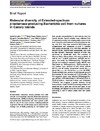Please use this identifier to cite or link to this item:
https://accedacris.ulpgc.es/jspui/handle/10553/74667
| Title: | Molecular diversity of Extended-spectrum β-lactamase-producing Escherichia coli from vultures in Canary Islands | Authors: | Carvalho, Isabel Tejedor Junco, María Teresa González Martín, Margarita Rosa Corbera Sánchez, Juan Alberto Suárez Pérez, Alejandro Silva, Vanessa Igrejas, Gilberto Torres, Carmen Poeta, Patrícia |
UNESCO Clasification: | 241401 Antibióticos 3105 Peces y fauna silvestre |
Keywords: | Antimicrobials Escherichia coli Vultures Canary Islands |
Issue Date: | 2020 | Journal: | Environmental Microbiology Reports | Abstract: | Antimicrobial resistance among isolates from wild animals is increasingly reported. Extended-spectrum beta-lactamase (ESBL)-producing Enterobacteriaceae, and particularly Escherichia coli, have spread worldwide as one of the most common multidrug-resistant organisms. The aim of this study was to determine the carriage rate of ESBL-producing E. coli isolates and their genetic characteristics in wild vultures from the Canary Islands. Faecal samples were collected from 22 apparently healthy free-ranging (wild) vulture chicks from Lanzarote and Fuerteventura (Canary Islands) during July 2019. They were seeded in MacConkey agar supplemented with cefotaxime (2 μg ml−1). Colonies with typical morphology of E. coli were identified by MALDI-TOF-MS. Antimicrobial susceptibility was done by disk diffusion. Phenotypic detection of ESBL was performed by double-disk tests. The presence of blaCTX-M, blaSHV, blaTEM, blaKPC and blaOXA-48 genes, as well as mcr-1 (colistin resistance), tetA/tetB and int1 gene, was tested by PCR/sequencing. Phylogenetic groups and multilocus sequence typing (MLST) were determined by PCR/sequencing. ESBL-producing E. coli isolates were detected in 5/22 tested animals (22.7%), and all isolates (one/animal) carried blaCTX-M genes: blaCTX-M-15 (n = 3) and blaCTX-M-55 (n = 2). ESBL-positive isolates were ascribed to phylogenetic group D (two isolates), B1 (two isolates) and A (one isolate), and five sequence types were detected (ST/phylogenetic-group/ESBL): ST515/B1/CTX-M-15, ST1290/A/CTX-M-15, ST38/D/CTX-M-15, ST457/D/CTX-M-55 and ST6448/B1/CTX-M-55; this suggests a genetic diversity among these isolates. Three CTX-M-15-producing isolates contained the blaTEM gene and one the tetA gene. To our knowledge, this appears to be the first report of ESBL-producing E. coli in vulture chicks from the Canary Islands. | URI: | https://accedacris.ulpgc.es/handle/10553/74667 | ISSN: | 1758-2229 | DOI: | 10.1111/1758-2229.12873 | Source: | Environmental Microbiology Reports [EISSN 1758-2229], v. 12 (5), p. 540-547, (Enero 2020) |
| Appears in Collections: | Artículos |
SCOPUSTM
Citations
9
checked on Jun 8, 2025
WEB OF SCIENCETM
Citations
9
checked on Jun 8, 2025
Page view(s)
196
checked on May 17, 2025
Download(s)
424
checked on May 17, 2025
Google ScholarTM
Check
Altmetric
Share
Export metadata
Items in accedaCRIS are protected by copyright, with all rights reserved, unless otherwise indicated.
